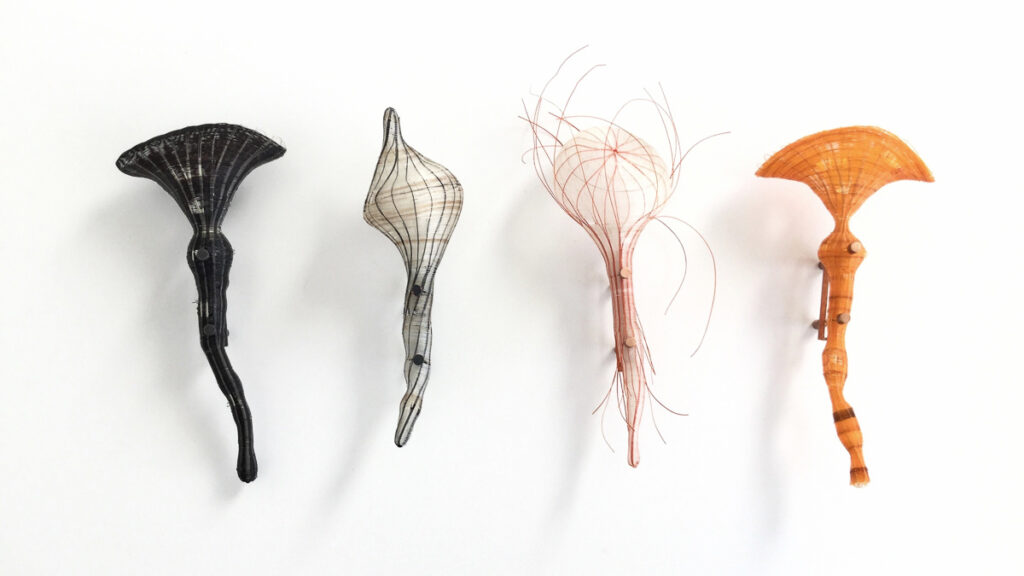
Rita Soto, Kashpij spirits
Rita Soto Ventura makes horsehair jewellery inspired by the folklore of the Yagan peoples from Tierra del Fuego
During this COVID-19 pandemic, quarantine has been extended for over five months in Santiago, where I live. We were all confined to our homes, knowing that death and hunger existed on the other side of our walls. I took my time to re-engage in this series, immersing myself in research about the Yagan people. It was paradoxical to face the history of these people and their death after colonisation, which was mainly caused by disease, while at the same time, looking at humanity today in 2020, where we are facing a virus travelling throughout the whole world, killing us and generating panic, as well as extended isolation.
During the cold and precarious time of winter, I felt the need to create with whatever means I had access, and I rediscovered my garden. I crumbled a dead plant from the previous summer and collected its roots and tuber, hence discovering a micro-world of tiny filaments.
It was in this scenario where I finally understood how we relate to our surroundings and survive in our environment made of objects as well as imaginary worlds. I also understand the significance of indigenous presence in the territory we inhabit and the value of listening to their voices and showing respect for their legacy.
Today, Yagan spirits continue to sail the seas of Mother Earth.
From viewing this part of Chile to examining the most Southern region, I had to shred my cultural roots little by little. Formal education in Chile tends to omit knowledge about our cultural background, leading us to forget our ancestors, therefore resulting in ignorance about the first inhabitants who discovered this land.
From an early age, we are taught that the austral zone in South America was at one time populated by natives who do not exist anymore. Books merely mention the name of ethnicities and few details concerning their location, and their way of life, etc. These native peoples were the Kawéskar, the Yaganes, the Selk´nam, and the Aónikenk.
Some years ago while visiting bookstores, I found some books with photographic images of indigenous peoples from Austral Patagonia. These pictures were a great discovery for me! They look like characters from tales or perhaps even movies. The black and white images depicted women and men, naked or covered with animal skin, their faces, and body paint. These were the Amirindio inhabitants… it was time to get to know them!
Information about these territories was first compiled at the end of the nineteenth century when the colonising countries claimed property in South America and set up territorial borders. This concept did not exist before colonisation in this part of the world, on the contrary, native people shared their land. Until recently, we are now able to recognize the voice of ethnic groups and witness the development of events in the territory framed between the Andes and the Pacific Ocean.
What occurred to native people in this area has been called genocide: their land was usurped for commercial purposes. Colonisers attempted to “civilise” aboriginal people, forcing them to change their way of life, their names, their clothing, and even their diet. Additionally, native people were forced into slavery, living in overcrowded places with poor sanitary conditions, where they were either killed by disease or slain. In this scenario, Indigenous people were finally exterminated.
In my development as an artist, and during my construction process, I used to read and research topics I wished to explore, by offering my insight from an artistic perspective in jewellery. I construct objects which generally tell us stories and become small portable sculptures. Using the traditional technique of micro-basketry with horsehair, I have been able to construct pieces that generate a permanent dialogue between technique, materials, and stories.
From this perspective some years ago, I started bibliographical and audiovisual research about the Yagan people. I was captivated by the recordings of songs and tales unfolding their collective imagery. Yagans have a fascinating imagery of spirits, animal tales, transmutation, nature, and the sea. It inspired me to build and materialise creatures made from textiles. I created and knitted enigmatic shapes while listening to Ursula Calderon´s singing in her mother tongue Hausikuta, a musical language that takes us to those austral places.
I found Rosa Yagán´s valuable testimony in the book, Lakutaia Le Kipa, written by Patricia Stambuk, and illustrated by an invaluable photo collection by Martín Gusinde, a Polish priest and ethnologist well known for his anthropological work pertaining to native people in Tierra del Fuego between the years 1918 – 1924. This is how the series Sailing Spirits from the End of the World was born.
To accurately read the past one must illuminate the present. This is what I learnt from those books.
The Yagan people are the most austral on the planet. For over six thousand years, they have travelled through channels and islands of the Cabo de Hornos Archipelago, at the most southern tip of south of America. With the arrival of the white man to their territories, their way of living was abruptly interrupted. They started to disappear since they were expelled from their traditional waterways and islands. Today, they mainly live on Ukika, Puerto Williams in Navarino island.
The Yagans were nomads and had unlimited mobility. On their canoes, they fished and could land and live wherever they wanted. They were a passive community. The main occupation was to obtain food daily. They spent a big portion of their life on their canoes made of wood and coihue bark, native trees of the southern zone. On them, they travelled the coastal regions, eventually meeting on land, building huts made of wooden structures topped with tree branches, animal skin, and fur.
They lived with very few personal belongings, including hunting weapons, hampers, ornaments made by women, and toys for children. As a family, they owned awnings, canoes, furs, and food.
The Yagans had a profound respect for nature and their overall environment. They would hunt animals only for daily consumption, including sea lions, whales, otters, and poultry. They were able to resist extreme temperatures by applying fat from sea lions onto their skin and also used furs from animals as clothing.
The Yagan people had a deep respect for their elders, who would hand down ancestral knowledge to their younger family members, preparing them for everyday life and the future. They were amiable people and great storytellers, sitting around fires in groups where they would emphasize the importance of building community through collaboration in gathering food. They also had small, controlled fires inside in their canoes to keep warm.
Fire had great relevance for these people; they would burn firewood while discussing important issues related to the community’s well being. Examples of this could be to announce a death or grounding of a whale; sources of food, which they would share with the entire community.
Tierra del Fuego (Land of Fire Archipelago), was named after Magallanes when in the year 1520 he discovered the strait that today bears his name, which connects the Pacific Ocean with the Atlantic. The boats had no contact with the natives, they only spotted a large number of bonfires in the distance, which were lit by the natives to warn that something out of the ordinary was happening.
The Yagans named each section of the ocean, and the land inside their territory. Also, they received their names from the areas in which they were born. With colonisation, people and places were re-baptised by British missionaries, and eventually, their original names were lost.
Yagans did not worship any god, they believed in entities that could incarnate and take form in any object or place.
Many legends share the transformation from humans into animals or stones into humans. According to their history of creation, everyone and everything was once human, including the sun, the moon, and the birds. After a great universal flood, each being was able to choose what he or she wanted to be. They became birds, whales or sea lions, in this manner, sky, land and ocean are populated as we know them today.
The Káshpij spirits were present in these stories, malignant spirits, protecting spirits, forest, and water spirits, the type of spirit was determined by the wizard. When a Yagan died they believed that it became a hill or if it died in the sea they thought that the spirit remained sailing in the ocean.
Yagans believed that wandering spirits will not let them resign to their end. However, with the arrival of white men, Yagans lived with fear and sadness, a sense of loss, and insecurity. They had to make important decisions about how to keep their “Etnia” alive. They fought for preserving their lifestyle and culture and made an effort to teach their children and teens their way of life, such as building canoes. Nevertheless, they witnessed a reduction of 90 % of their population in just 15 years.
Today, Yagans are not an extinct group of people. Furthermore, they have become communities of resistance, capable of documenting stories about their conception of the world, as well as their way of life. Modern society has a great opportunity to learn from them.
This vision of the Yagan world, brought me to generate a bond with these spirits, as well as a need to create and give these beings a shape. By visualisation of our surroundings and survival, we can relate to our environment, the objects and our imaginary.
Each created piece in this series holds the name of a significant Yagan character from a story. Now and then I return to their world. The language has changed, intervening and transforming natural materials that are transmuted into a new Kashpij.
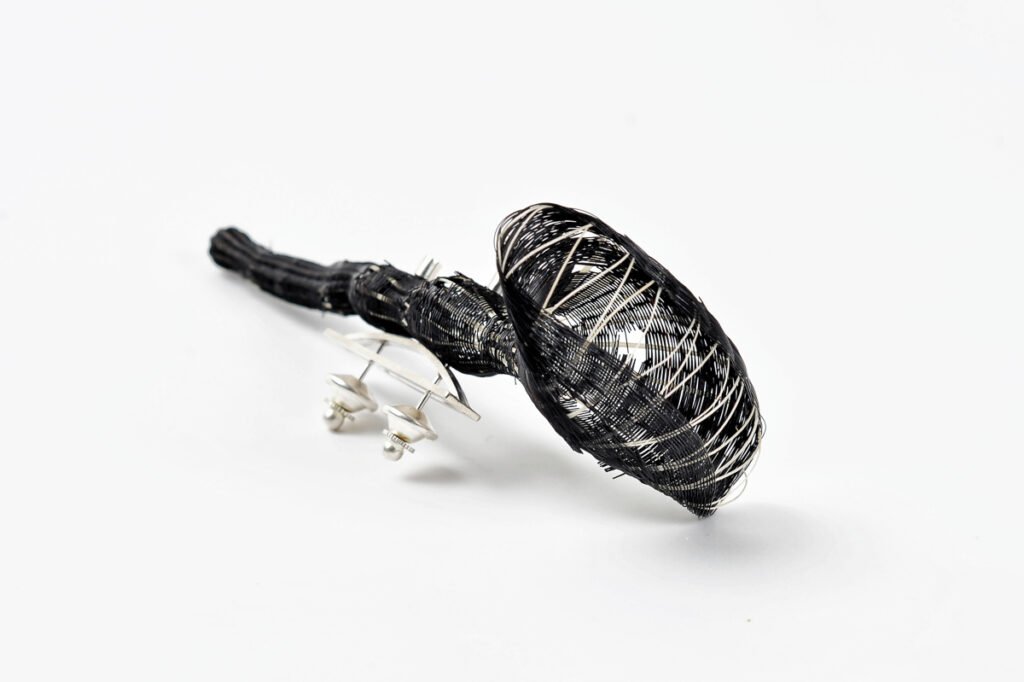
Rita Soto, LAKUTAIA LE KIPA, Brooch, 2017. Materials: Horsehair, vegetable fiber tampico, silver, rubber, steel. Dimensions: 130x65x30 mm
Le kipa means woman: Lakutaia le kipa is the protagonist in a book I worked with. Her testimony has great value. I developed two equal pieces made of natural horsehair: one is black and the other is white. They symbolise her nomad childhood, experiencing Yagan rituals. Lakutaia le kipa, breaches to a different world, to a colonial time in which she faces a new reality and is rebaptized as Rosa Yagan.
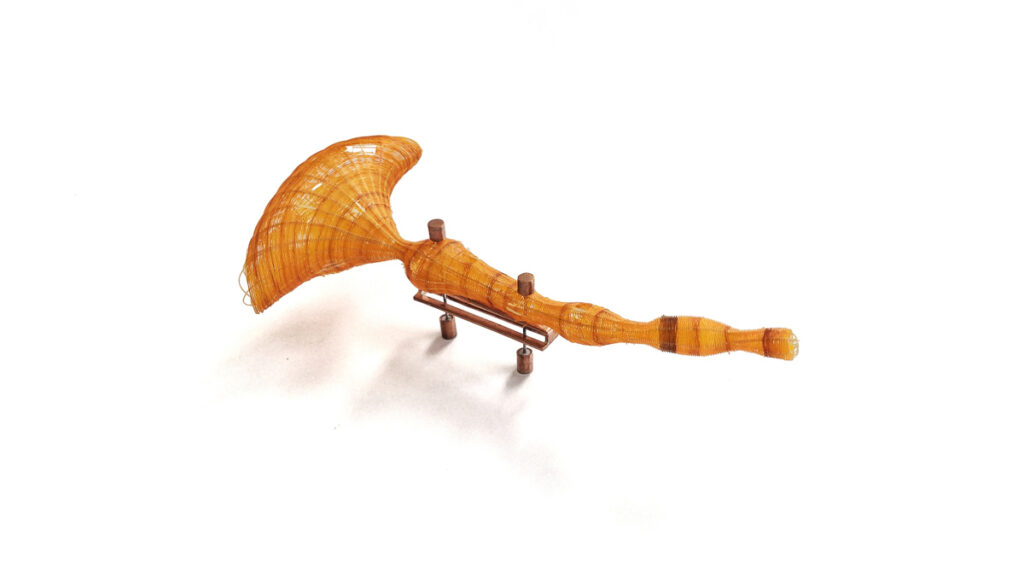
Rita Soto, SHUMONAIA LE KIPA, Brooch, 2017. Materials: Horsehair, vegetable fiber tampico, silver, rubber, steel. Dimensions: 130x65x30 mm
She was Lakutaia le kipa´s godmother and a great partner who took care of and protected her; she was a sorceress.
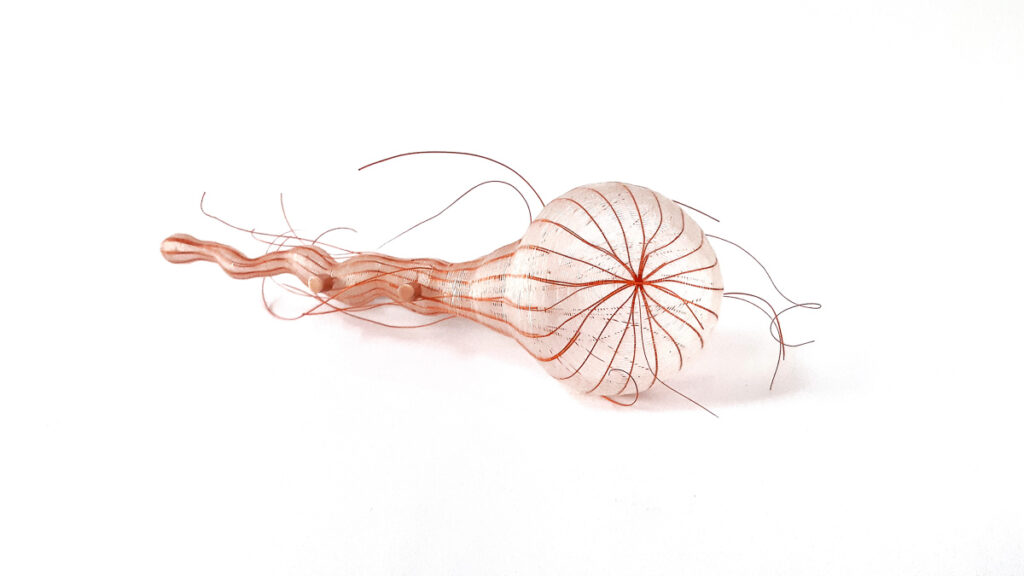
Rita Soto, CARRUPAKÓ LE KIPA, Brooch, 2017. Materials: Horsehair, vegetable fibre tampico, copper, rubber, steel. Dimensions: 130x45x35 mm
She was the oldest woman at the time, therefore named queen of Yagans. She taught Martín Gusinde about Yagan culture. Her white hair and long-lasting deep features inspired me to create a light piece, translucid with delicate electric lines of power and light.
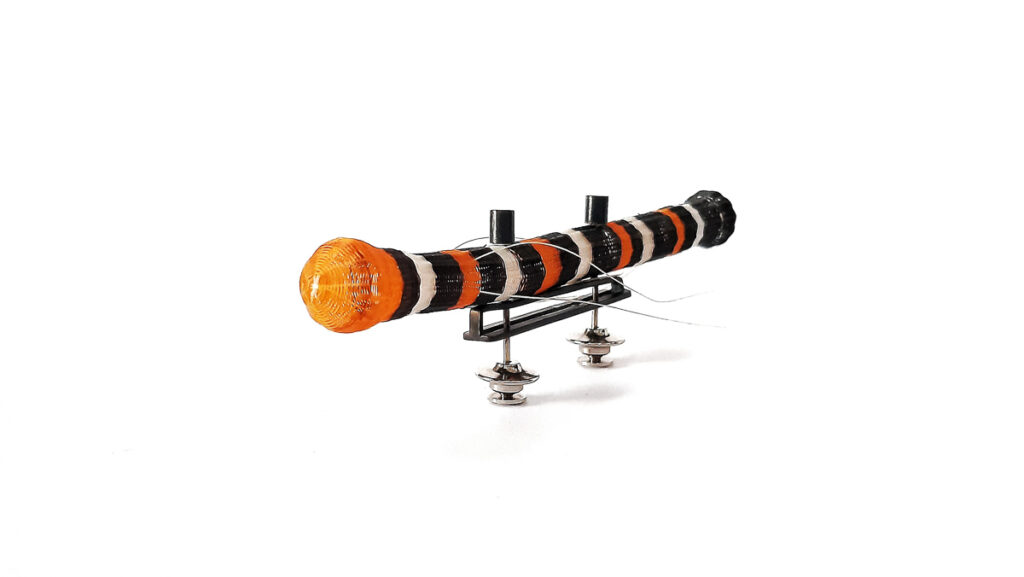
Rita Soto, ILUKUISH INDSCHIS, Brooch, 2018. Materials: Horsehair, vegetable fiber tampico, patinated copper, rubber, steel. Dimensions: 110x30x10 mm
A wizard apprentice; I visualized him as agile and a jovial spirit of vibrant colors.
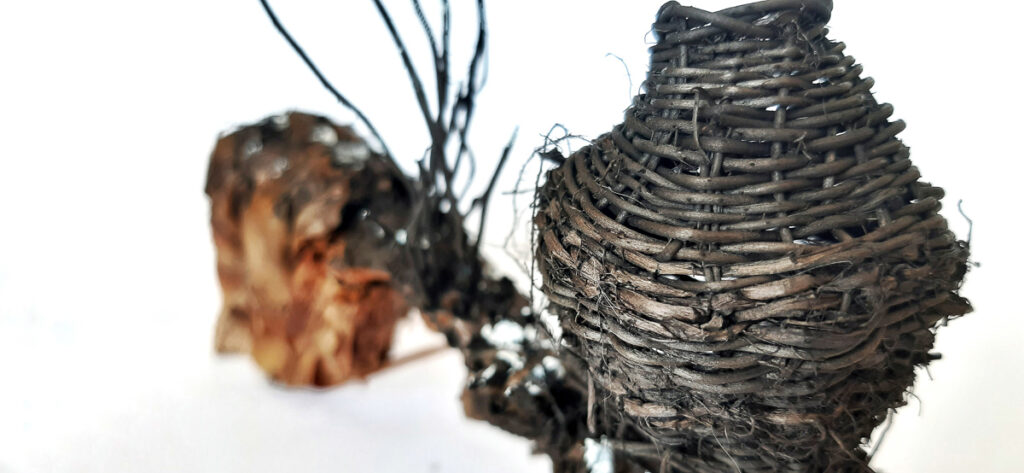
Rita Soto, LANAMUTEKENSH, Brooch, 2020. Materials: Tuber and papyrus roots, acrylic paint, silver, steel. Dimensions: 130x90x40 mm
Is the husband of Lakutaia le kipa, and was the chief of Yagans from Mejillones. He was raised by a Yugoslavian man, and spent his childhood as a shepherd, ploughing the earth. Therefore, I wanted to connect him to the land, to the continent, and to the growth of roots. For this piece, it was the first time I incorporated tubers and papyrus roots.

Rita Soto, MALAKAMATO, Brooch, 2020. Materials: Papyrus roots and vegetable fibre tampico dyed , silver, steel. Dimensions: 140x40x40 mm
One of Yagan´s twins. Whenever twins were born in the community, it was considered peculiar. I constructed two identical pieces, using the roots from the same tuber.
Translation to English by Elisa Ortiz
Bibliography
Alonso Marchante, J. (2020). Selk´nam Genocidio y Resistencia. Editorial Catalonya.
Barthe, C. y Barral, X. (2014). El espíritu de los hombres de Tierra del Fuego – Portafolio Martín Gusinde, Tierra del Fuego 1918-1924. Ediciones Xavier Barral.
Chapman, A. (2012). Yaganes del Cabo de Hornos. Pehuén Editores.
Stambuk, P. (1986). Rosa Yagán -Lakutaia le kipa. Pehuén Editores.
Vargas Filgueira, V. (2019). Mi Sangre Yagán. Editora Cultural Tierra del Fuego.
References
Azócar, C. y Serrano, A. (Directores). (2016). Tánana, estar listo para zarpar (Documental).
Cheuquelaf, R. (2009). KULUANA (Disco). Relatos y cuentos Yaganes de Ursula Calderón. Música: Lluvia Acida.
De Agostini, A. (Director). (1918). Tierras Magallánicas (Documental).
Gusinde, M. (1923). Registro Cantos Kawésqar. Tierra del Fuego, Chile.
https://archives.crem-cnrs.fr/…/CNRSMH_E_2006_010_001_19/Mülchi, H. (Director). (2010). Cristina Calderón: La dueña del fin del mundo (Documental).
Author
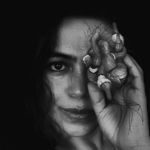 Rita is a jewellery artist living in Santiago, Chile. She studied Industrial Design and Cultural Management in Santiago. She worked collaborating on various Crafts and Design projects. Since 2002 she has learned the jewellery trade from her father. In 2012 she formed LAJOIA jewellery school. Between 2014 and 2018, she held the position of President of JOYABRAVA Association. She has developed a deep work of relevance to the micro basketry technique, researching, experimenting and generating pieces that stand out for their innovation and sensitivity. In 2018, she was a LOEWE Craft Prize finalist. “My work comes from the search for a language of its own and from textile experimentation, working for many years with natural fibers and traditional basketry techniques from my country, added to the knowledge of the jewellery trade that has allowed me to generate a proposal around textile bodies and wefts. Creating biomorphic objects, textile creatures that dialogue between the organic and the poetic, weaving identities, interweaving imaginary. Transforming these objects into pieces of art jewellery”. Follow her at @ritasotojoyas or visit www.ritasoto.cl.
Rita is a jewellery artist living in Santiago, Chile. She studied Industrial Design and Cultural Management in Santiago. She worked collaborating on various Crafts and Design projects. Since 2002 she has learned the jewellery trade from her father. In 2012 she formed LAJOIA jewellery school. Between 2014 and 2018, she held the position of President of JOYABRAVA Association. She has developed a deep work of relevance to the micro basketry technique, researching, experimenting and generating pieces that stand out for their innovation and sensitivity. In 2018, she was a LOEWE Craft Prize finalist. “My work comes from the search for a language of its own and from textile experimentation, working for many years with natural fibers and traditional basketry techniques from my country, added to the knowledge of the jewellery trade that has allowed me to generate a proposal around textile bodies and wefts. Creating biomorphic objects, textile creatures that dialogue between the organic and the poetic, weaving identities, interweaving imaginary. Transforming these objects into pieces of art jewellery”. Follow her at @ritasotojoyas or visit www.ritasoto.cl.

